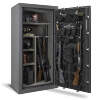Can you at least tell us who made it or the model so we can look for it?
Decorative "safes" are typically Residential Security Containers instead of rated safes. They're to keep the kids and casual burglar out, but not too much more. They provide inadequate fire protection, but frankly most rated safes provide inadequate protection in a house fire as they basically become a steam bath for the contents and then an oven. Only highly insulated safes give enough protection long enough to keep from ruining the guns inside.
If you're going to try to improve the fire protection of the thing you should look at better products than "drywall" which "protects" by giving up moisture as the heat reaches it (remember steamer comment above). Ceramic insulation from the fireplace store is a good dry alternative an can be had in panels. Where you site the thing in the house also affects how long it is exposed to how much heat in anything short of a full engulfment.
Also pay attention to locating the safe when thinking about fire protection. You'll want to locate it in the part of the structure that is likely to survive a house fire and that won't be found floating in water from the FD surrounding and drowning the house fire with hoses spraying thousands of gallons of water on/into the house.
If you're going to put it on concrete you should consider a barrier between the mild steel bottom and the concrete so you reduce the chance of corrosion.




